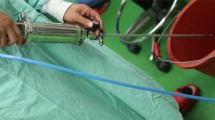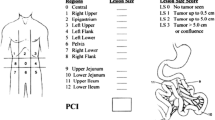Abstract
Induction of hyperthermia in dogs by irrigation of the peritoneal cavity via a closed circuit system was evaluated for possible use in the management of cancer patients. Dogs were subjected to lavage of the peritoneal cavity with crystalloid solution at 41°–43°C in a closed circuit system. Temperatures of the liver and hollow viscera were maintained at 40°–42°C for 4 hours. The animals tolerated the procedure, and the parietal incisions and intestinal anastomoses healed without difficulty. Evidence of toxicity was minimal. Plans for studies of this modality in patients with cancer are underway.
Résumé
La tolérance à l'irrigation de la cavité péritonéale par une solution chaude contenant des électrolytes a été étudiée chez le chien dans le but de provoquer une hyperthermie régionale et d'appliquer cette méthode à l'homme atteint d'un processus tumoral abdominal. L'irrigation a été réalisée avec une solution dont la température allait de 41 à 43°C et à l'aide de cathéters intra-péritonéaux réalisant un circuit fermé.
Les résultats de l'expérimentation se sont soldés par un taux élevé de survie et un taux faible de complications. Ces faits ont démontré que la méthode pouvait s'appliquer à l'homme. L'hyperthermie régionale obtenue par l'irrigation intra-péritonéale avec un liquide chaud renforce chez le cancéreux l'action des radiations ionisantes et des drogues anti-mitotiques.
Resumen
La tolerancia de los animales a la irrigación de la cavidad peritoneal con solución electrolítica caliente fue estudiada en perros en preparación para la aplicación de esta modalidad en el manejo de pacientes con cancer. Mediante laparotomía se colocaron catéteres en la cavidad peritoneal, los cuales fueron utilizados para irrigar con solución electrolítica calentada a un nivel de 41° a 43°C. La operación, la exposición y el lavado peritoneal fueron bien tolerados por los animales, habiéndose observado una alta tasa de supervivencia y una baja tasa de complicaciones, lo cual indica que este procedimiento podría ser adaptado para uso en humanos. Existe un gran volumen de evidencia que señala que la irrigación de la cavidad peritoneal, de tipo agudo o crónico, es un procedimiento seguro. Las temperaturas supranormales, las cuales actúan potenciando la acción de las radiaciones ionizantes o de las drogas anticancerosas en el manejo de pacientes con cáncer, pueden ser producidas, mediante la técnica que aquí se informa, con secuelas tolerables.
Similar content being viewed by others
References
Coley, W.B.: Treatment of malignant tumors by repeated inoculations of erysipelas with report of 10 original cases. Am. J. Med. Sci.105:487, 1983
Woodhall, B., Pickrell, K.L., Georgiade, N.G., Mahaley, M.S., Dukes, H.T.: Effect of hyperthermia upon cancer chemotherapy: Application to external cancers of head and face structures. Ann. Surg.151:750, 1960
Cavaliere, R., Ciocatto, E.C., Giovanella, B.C., Heidelberger, C., Johnson, R.O., Margottini, M., Mondovi, B., Moricca, G., Rossi-Fanelli, A.: Selective heat sensitivity of cancer cells. Cancer20:1351, 1967
Pettigrew, R.T., Galt, J.M., Ludgate, C.M., Smith, A.N.: Clinical effects of whole-body hyperthermia in advanced malignancy. Br. Med. J.4:679, 1974
Light, S., editor: Therapeutic Heat, 2nd edition. Baltimore, Waverly Press, 1965
Storm, F.K., Harrison, W.H., Elliott, R.S., Morton, D.L.: Normal tissue and solid tumor effects of hyperthermia in animal models and clinical trials. Cancer Res.39:2245, 1979
Parks, L.C., Smith, G.V.: Extracorporeal induction of systemic hyperthermia techniques: Effects on man and malignancy. In Hyperthermia in Cancer Therapy, F.K. Storm, editor, Boston, G.K. Hall, 1983
Crile, G., Jr.: The effects of heat and radiation on cancer implanted on the feet of mice. Cancer Res.23:372, 1963
Giovanella, B.C., Stehlin, J.S., Jr., Morgan, A.C.: Selective lethal effect of supranormal temperatures on human neoplastic cells. Cancer Res.36:3944, 1976
Overgaard, K., Overgaard, J.: Investigations on the possibility of a thermic tumor therapy. I. Short wave treatment of a transplanted isologous mouse mammary carcinoma. Eur. J. Cancer8:65, 1972
Overgaard, J.: Fractionated radiation and hyperthermia: Experimental and clinical studies. Cancer48:1116, 1981
Krementz, E.T., Carter, R.D., Sutherland, C.M., Hutton, I.: Chemotherapy of sarcomas of the limbs by regional perfusion. Reports of 113 cases from 1957–1975. Ann. Surg.185:555, 1977
Krementz, E.T., Ryan, R.F.: Chemotherapy of melanoma of the extremities by perfusion: Fourteen years' clinical experience. Ann. Surg.175:900, 1972
Barlogie, B., Corry, P.M., Drewinko, B.: In vitro thermochemotherapy of human colon cancer cells with cis-dichlorodiammineplatinum(II) and mitomycin C. Cancer Res.40:1165, 1980
Lele, P.P.: Thresholds and mechanisms of ultrasonic damage to organized animal tissues. In Symposium of Biological Effects and Characterization of Ultrasound Sources, D.G. Hazzard, M.L. Litz, editors, Proceedings of a Conference in Rockville, Maryland, June 2–3, 1977. HEW Publication (FDA) 78–8048, p. 224
Proceedings of the International Symposium on Cancer herapy by Hyperthermia and Radiation. Washington, D.C., April 28–30, 1975. Sponsored by the National Cancer Institute and the American College of Radiology
Lash, R.F., Burdette, J.A., Ozdil, T.: Accidental profound hypothermia and barbituate intoxication. J.A.M.A.201:269, 1967
Patton, J.F.: Renal function after core and surface rewarming of hyperthermic dogs. In International Symposium on Circumpolar Health, J.S. Roy, editor, Toronto, University Press, 1973
Tenckhoff, H., Schecter, H.: A bacteriologically safe peritoneal access. Trans. Am. Soc. Artif. Int. Organs14:181, 1968
Spratt, J.S., Adcock, R.A., Sherrill, W., Travathen, S.: Hyperthermic peritoneal perfusion system in canines. Cancer Res.40:253, 1980
Shiu, M., Fortner, J.G.: Surface heat therapy of implanted peritoneal cancer. Surg. Forum30:136, 1979
Euler, J., Priesching, A., Wenzl, J., Sauermann, G., Kloeckler, K., Kretschmer, G.: Hyperthermic peritoneal perfusion in ascites tumor in rats. Cancer Res.86:220, 1974
Palta, J.R.: Design and testing of a therapeutic infusion filtration system. M.S. Thesis, University of Missouri, Columbia, Missouri, 1977
Jenkins, J., Sugarbaker, P.H., Gianola, F.J., Meyers, C.E.: Technical considerations in the use of intraperitoneal chemotherapy administered by Tenckhoff catheter. Surg. Gynecol. Obstet.154:858, 1982
Lele, P.P., Bertino, J.R., Erivin, T.J., Feldman, M.I., Frei, E., III, Kowal, C.D.: Clinical evaluation of local hyperthermia by focused ultrasound. In The Third International Symposium: Cancer Therapy by Hyperthermia, Drugs and Radiation, Fort Collins, Colorado, June 22–26, 1980
Daly, J.M., Smith, G., Frazier, H., Dudrick, S.J., Copeland, E.M.: Effects of systemic hyperthermia and intrahepatic infusion with 5-fluorouracil. Cancer49:1112, 1982
Larkin, J.M., Edwards, W.S., Smith, D.E.: Total body hyperthermia and preliminary results in human neoplasms. Surg. Forum27:121, 1976
Larkin, J.M., Edwards, W.S., Smith, D.E., Clark, P.J.: Systemic thermotherapy: Description of a method and physiologic tolerance in clinical subjects. Cancer40:3155, 1977
Dickson, J.A., MacKenzie, A., McLeod, K.: Temperature gradients in pigs during whole-body hyperthermia at 42°C. J. Appl. Physiol.47:712, 1979
Speyer, J.L., Sugarbaker, P.H., Collins, J.M., Dedrick, R.L., Klecker, R.W., Jr., Myers, C.E.: Portal levels and hepatic-clearance of 5-fluorouracil after intraperitoneal administration in humans. Cancer Res.41:1916, 1981
Ozols, R.F., Locker, G.Y., Doroshow, J.H., Grotzinger, K.R., Myers, C.E., Young, R.C.: Pharmacokinetics of adriamycin and tissue penetration in murine ovarian cancer. Cancer Res.39:3209, 1979
Ozols, R.F., Young, R.C., Speyer, J.L., Weltz, M., Collins, J.M., Dedrick, R.L. Meyers, C.E.: Intraperitoneal (IP) adriamycin (ADR) in ovarian carcinoma (OC). ASCO Abstracts, 1980, p. 425 #C–423
Ozols, R.F., Locker, G.Y., Doroshow, J.H., Grotzinger, K.R., Myers, C.E., Fisher, R.I., Young, R.C.: Chemotherapy for murine ovarian cancer: A rationale for ip therapy with adriamycin. Cancer Treat. Reports63:269, 1979
Jones, R.B., Myers, C.E., Guarino, A.M., Dedrick, R.L., Hubbard, S.M., DeVita, V.T.: High volume intraperitoneal chemotherapy (“belly bath”) for ovarian cancer. Cancer Chemother. Pharmacol.1:161, 1978
Berndt, W.O., Gosselin, R.E.: Rhubidium and creatinine transport across isolated mesentery. Biochem. Pharmacol.8:359, 1961
Kim, J.H., Hahn, E.W.: Clinical and biological studies of localized hyperthermia. Cancer Res.39:2258, 1979
Streffer, C., editor: Cancer Therapy by Hyperthermia and Radiation. Baltimore-Munich, Urban & Schwarzenberg, 1978
Grogan, J.B., Parks, L.C., Minaberry, D.: Polymorphonuclear leukocyte function in cancer patients treated with total body hyperthermia. Cancer45:2611, 1980
Smith, G.V., Grogan, J.B., Stribling, J., Lockard, J.: Immunochemotherapy of hepatoma in rats. Am. J. Surg.129:146, 1975
Oberfield, R.A., McCaffrey, J.A., Polio, J., Clouse, M.E., Hamilton, T.: Prolonged and continuous percutaneous intraarterial hepatic infusion chemotherapy in advanced metastatic liver adenocarcinoma from colorectal primary. Cancer44:414, 1979
Sears, H.F., Mattis, J., Herlyn, D., Hayry, P., Atkinson, B., Ernst, C., Steplewski, Z., Koprowski, H.: Phase-I clinical trial of monoclonal antibody in treatment of gastrointestinal tumours. Lancet1:762, 1982
Author information
Authors and Affiliations
Additional information
Supported in part by Grant #68930 from NIH Biomedical Research Funds.
Rights and permissions
About this article
Cite this article
Smith, G.V., MacMillan, R. & Stribling, J. Intraperitoneal approach to regional hyperthermia—possible anticancer applications. World J. Surg. 7, 732–737 (1983). https://doi.org/10.1007/BF01655213
Issue Date:
DOI: https://doi.org/10.1007/BF01655213




